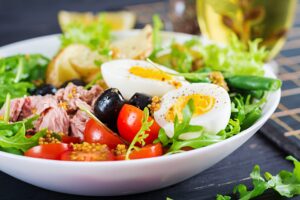Are you ready to unlock the secrets of enzymatic magic? Get ready to embark on a journey where enzymes become your guiding lights, leading you towards the path of fat breakdown and weight loss.
Imagine these enzymes as little wizards, working tirelessly behind the scenes to transform your body into a lean, mean, fat-burning machine.
Enzymes, those mystical catalysts of metabolism, hold the key to unlocking the energy stored in the fats you consume. They have a special power, a magical touch that allows them to break down these stubborn molecules and release their energy for your body to use. It’s like they have a secret recipe, a formula for fat destruction that leaves you feeling energized and revitalized.
But how exactly do these enzymes work their magic? What is the process they follow to break down fat molecules? And what factors influence their activity?
In this article, we will delve into the world of enzymatic catalysis, unraveling the mysteries of fat breakdown and exploring the applications of these powerful enzymes in your journey toward weight loss. So sit back, relax, and let the enzymatic magic transport you to a world where your desire to serve others is fulfilled by transforming your own body.
Key Takeaways
- Enzymes can accelerate weight loss by supercharging fat burning.
- Enzymes aid in the digestion of dietary fats, preventing fat accumulation and promoting nutrient absorption.
- Certain enzymes help regulate blood sugar levels and control cravings for unhealthy, high-calorie foods.
- Enzyme supplementation can increase energy levels and allow for more calorie burning.
Understanding Enzymes and Their Role in Metabolism
Just as a conductor directs an orchestra, enzymes serve as the maestros of metabolism, orchestrating the breakdown of fats with their enzymatic magic.
Enzymes are incredible molecules that play a crucial role in our bodies’ ability to break down and utilize fats for energy. They act as catalysts, speeding up the chemical reactions that break down fats into smaller molecules that can be easily absorbed and used by the body.
Enzymes are like little helpers that work tirelessly to ensure that the fats we consume are efficiently broken down and utilized. They are highly specific, meaning that each enzyme is designed to work on a particular type of fat molecule. This specificity allows them to target and break down specific fats, ensuring that our bodies can extract the maximum amount of energy from our food.
Imagine you’re a busy server in a restaurant, and your goal is to provide the best service to your customers. Just as you have different tasks assigned to you, enzymes also have specific roles in metabolism. Each enzyme has a job to do, whether it’s breaking down triglycerides into fatty acids or converting cholesterol into bile acids.
They work together in a coordinated manner, just like a team of servers in a restaurant, to ensure that the breakdown of fats is efficient and effective.
So, the next time you enjoy a delicious meal, remember the enzymatic magic happening inside your body. Enzymes are the unsung heroes that make it possible for your body to break down fats and use them for energy. They’re the maestros of metabolism, conducting the symphony of fat breakdown with precision and efficiency.
The Process of Fat Breakdown
First, let’s dive into the fascinating process of how your body breaks down fat. It’s truly remarkable how your body can transform stored fat into usable energy.
Here’s a step-by-step breakdown of the process:
- Lipolysis: This is the initial step where enzymes called lipases break down the fat molecules into smaller components called fatty acids and glycerol. These enzymes work tirelessly to release the energy stored in the fat cells.
- Transport: Once the fatty acids and glycerol are released, they need to be transported to the mitochondria of your cells where they can be further broken down. This is where the magical enzyme carnitine comes into play. Carnitine helps shuttle the fatty acids across the mitochondrial membrane, ensuring they reach their destination.
- Beta-oxidation: Inside the mitochondria, another group of enzymes called beta-oxidation enzymes take over. They break down the fatty acids into acetyl-CoA, which can then enter the citric acid cycle to produce energy-rich molecules like ATP.
- Energy production: The acetyl-CoA produced from fat breakdown goes through a series of chemical reactions in the citric acid cycle, ultimately leading to the production of ATP, the energy currency of your cells. This energy is then used to fuel various processes in your body, allowing you to move, think, and serve others.
Knowing how your body breaks down fat can help you make informed decisions about nutrition and exercise. By taking care of your body and providing it with the right fuel, you can support this enzymatic magic and ensure that your body is functioning at its best.
Enzymatic Catalysis: Breaking Down Fat Molecules
Contrary to popular belief, these remarkable biological agents possess the extraordinary ability to facilitate the disintegration of lipid molecules. Enzymes, those magical little catalysts found within your body, are the key players in breaking down fat molecules. They work tirelessly to ensure that the fats you consume are broken down into smaller components that can be easily absorbed and utilized by your body.
Picture this: you’ve just finished a delicious meal containing a generous amount of fat. As you digest your food, enzymes like lipases come into action. These enzymes are like the superheroes of your digestive system, swooping in to save the day. They attach themselves to the fat molecules and begin their enzymatic magic.
Through a series of chemical reactions, these enzymes break down the complex fat molecules into simpler components like fatty acids and glycerol. This process, known as hydrolysis, is essential for your body to extract the energy stored in fat and use it for various functions. Without the help of enzymes, this breakdown would be a slow and inefficient process.
Factors Affecting Enzymatic Activity in Fat Breakdown
To better understand the factors affecting enzymatic activity in fat breakdown, envision a complex web of variables that intertwine and influence the efficiency of this process. Imagine yourself as a master chef in a bustling kitchen, striving to create the most delicious and healthy dishes for your customers. You subconsciously desire to serve others, and understanding the factors that affect enzymatic activity in fat breakdown is crucial to achieving this goal.
One of the key factors that influences enzymatic activity in fat breakdown is temperature. Just like cooking a perfect dish, the temperature must be just right for the enzymes to work their magic. Too low of a temperature and the enzymes become sluggish, slowing down the breakdown process. On the other hand, too high of a temperature can denature the enzymes, rendering them useless. As a chef, it’s your responsibility to carefully control the temperature, ensuring that it is optimal for the enzymes to work at their full potential.
Another factor that affects enzymatic activity in fat breakdown is pH level. Think of the pH level as the seasoning of the enzymatic process. Just like how the right amount of salt enhances the flavor of a dish, the right pH level enhances the efficiency of the enzymes. Different enzymes have different optimal pH levels, so it’s essential to understand which enzymes are involved in fat breakdown and adjust the pH accordingly. As a chef, you have the power to create the perfect environment for enzymatic activity by carefully balancing the pH level.
How do Enzymes Catalyze the Breakdown of Carbohydrates, Proteins, and Fats?
Enzymes play a crucial role in the introduction to nutrients in food by catalyzing the breakdown of carbohydrates, proteins, and fats. They speed up the chemical reactions that break down these macronutrients into smaller molecules, allowing the body to absorb and utilize them for energy, growth, and repair.
Applications of Enzymes in Fat Breakdown and Weight Loss
Imagine shedding those extra pounds effortlessly with the help of enzymes, like a piece of cake! Enzymes are vital in fat breakdown and weight loss, offering a magical solution to achieving your desired body shape.
Here are four exciting applications of enzymes in fat breakdown and weight loss that will make you jump for joy:
- Enhanced Fat Burning: Enzymes, such as lipases, break down fats into smaller components that can be easily metabolized by the body. By supplementing your diet with these enzymes, you can supercharge your fat burning process and accelerate weight loss.
- Improved Digestion: Enzymes also aid in the digestion of dietary fats, ensuring that they are properly broken down and absorbed by the body. This not only prevents fat accumulation but also promotes better nutrient absorption, leading to improved overall health.
- Reduced Cravings: Certain enzymes, such as amylases, can help regulate blood sugar levels and control cravings for unhealthy, high-calorie foods. By incorporating these enzymes into your diet, you can curb your cravings and make healthier food choices, ultimately leading to weight loss.
- Increased Energy: When enzymes efficiently break down fats, they release energy the body can utilize. By optimizing fat breakdown through enzyme supplementation, you can experience increased energy levels, allowing you to be more active and burn even more calories.
So, why wait? Embrace the power of enzymes and let them work their magic in helping you achieve your weight loss goals. With their assistance, shedding those extra pounds will feel like a breeze, leaving you feeling lighter, healthier, and happier.
Frequently Asked Questions
Can enzymes be used to break down fat in specific areas of the body?
Yes, enzymes can be used to break down fat in specific body areas. By targeting these enzymes to particular regions, they can effectively break down and remove excess fat, helping you achieve your desired body shape.
Are there any side effects or risks associated with using enzymes for fat breakdown?
When it comes to using enzymes for fat breakdown, you might be wondering about any potential side effects or risks. While enzymes can be effective, it’s important to consult with a healthcare professional to ensure your safety.
How long does it take for enzymes to break down fat molecules?
Enzymes work their magic by breaking down fat molecules, but the time it takes can vary. Factors like enzyme concentration and temperature play a role. On average, it can take anywhere from a few minutes to several hours.
Can enzymes be used to break down stubborn or hard-to-lose fat?
Stubborn fat got you down? Enzymes can be your secret weapon! They have the power to break down those hard-to-lose fat molecules, helping you achieve your weight loss goals. Give enzymes a try and watch the magic happen!
Are there any dietary restrictions or guidelines for using enzymes for fat breakdown and weight loss?
There are no specific dietary restrictions or guidelines for using enzymes for fat breakdown and weight loss. However, it is always recommended to maintain a balanced diet and consult with a healthcare professional for personalized advice.














